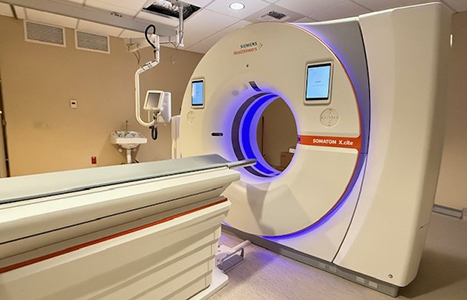||| FROM THE ROBB REPORT ||| posted at request of Orcasonian reader |||
We’ve already seen “flying” powerboats, catamarans and luxury yachts. Now, the ferry has been given wings.
Boundary Layer Technologies has just unveiled a new fully electric ferry with foils that allow it to literally soar across the ocean. Electra, which is fittingly named after the Greek Goddess of the Sea Clouds, promises to be an eco-friendly ruler of the high seas. In fact, the Californian startup says she’s twice as fast as existing electric ferries and can travel double the distance.
That’s all thanks to the company’s proprietary hydrofoil technology and podded propulsion system. In short, the foils lift the ferry up and out of the water to reduce drag by a factor of two, according to CEO Ed Kearney. This means Electra churns through half the energy of her battery-powered peers and thus boasts better performance specs. She can reportedly cover up to 100 nautical miles on a single charge and reach a blistering 40 knots at full tilt.

“This opens the door to the electrification of the majority of ferry routes across the world,” Kearney said in a statement.
Indeed, Electra could service more than 90 percent of commuter ferry routes in the US, as well as a number of far-reaching international sea lanes. Electra will also be fitted with a 9,000 kWh battery pack below deck that can be recharged in as little as three hours.
The 150 passengers onboard will likely enjoy a nice comfortable ride, too. The foiling system minimizes wake and increases overall seakeeping, while the battery-electric propulsion reduces cabin noise by up to 20 decibels compared to conventional ferries.
Electra could service more than 90 percent of commuter ferry routes in the US. Not to mention, the zero-emissions cruiser emits no fumes and could help reduce the industry’s carbon footprint. Patrick Murphy, president of the Blue & Gold Fleet, who is the contract operator of San Francisco’s 15 high-speed ferries, can certainly see the potential.
“We think Electra is an exciting development of ferry technology and shows promise for decarbonizing ferry operations and adding to the customer’s experience” Murphy adds.
Boundary Layer Technologies expects to have the first ferries in operation by the first quarter of 2024 in regions such as the US, Scandinavia and the Mediterranean.
**If you are reading theOrcasonian for free, thank your fellow islanders. If you would like to support theOrcasonian CLICK HERE to set your modestly-priced, voluntary subscription. Otherwise, no worries; we’re happy to share with you.**









Yep, the future is here! All we need to do is invest tax dollars in boondoggle tech and vaporware hyped by tech bros from California.
Here in the world of reality, we need plain old diesel ferries with crew that show up for the jobs they were hired to do.
We just watched the movie Avatar II. The blue Nav’ii fly through the waters of planet Pandora riding on the backs of exotic aquatic dinosaurs and 8-finned whale-like creatures who save the planet from bad humans.
Fun fantasy, but not real. Kind of like the CGI video in the above article. Unfortunately, battery mass and foiling ability are inversely related.
There was a guy on Mountain Lake last week who had a board half the size of a surf board with a hydrofoil under it powered by an electric motor and propeller. I was amazed at how fast he was able to zoom up and down the lake. This technology is well worth considering.
Wonder where they get the Lithium and Cobalt for the batteries.
Foiling boats are a thing in sailboat racing, most famously Americas Cup racers (30 knots+) but also smaller boats like Moths and WASZPs. Foiling ferries are also nothing new. Condor ran foiling passenger-only ferries between France, England, and the Channel Islands in the 80’s and early 90’s. We took one from Jersey to Guernsey in 1990 – a fast but rough ride. The Channel is often a nasty bit of water.
The enormous size and expense of the WSF system boats is entirely due to hauling cars and trucks. Obviously we will continue to need the WSF boats for those times when we need our vehicle on the mainland. But what about all those Costco trips and all those doctor’s appointments? Do you really need YOUR car? What if there were a fleet of small, electric rental cars waiting for the high speed ferry at a marina in Bellingham? Go shopping, go to the doctor, go out to dinner, etc. and then be back on Orcas faster than you could drive back to Anacortes . . . I for one, would be glad not to spend a 12 hour day just to see the dermatologist for 10 minutes!
@ken what a dream. Love it, and clearly the future up until eVTOL is a real thing. Then it’s even easier.
Nantucket and Martha’s Vineyard have both had passenger ferry service (no cars) via the privately run Hy-Line since the early 1960s. This is only viable because those islands have both local rental car fleets and public transportation service. If we want to have a comparable passenger ferry service (and reduce the impacts and costs of seasonal automobile traffic) the County needs to start planning to implement a modern and flexible local transportation alternative.
Good discussion. I am seconding Brian’s comment. Walk-on ferries go hand in hand with public transportation on both sides of the water. Council member Jane Fuller and I are on the SWISS transportation workgroup. SWISS is a collaborative organization of the five northwest counties in Washington State, including Snohomish, Whatcom, Island, Skagit, and San Juan Counties, with the Wash DOT in the mix. We are all collectively interested in and working toward a unified, clean, accessible and affordable regional public transit system. There are significant state and federal funds that can help.
The SJ County Climate and Sustainability Advisory Committee also includes a transportation workgroup, and we are looking at various options, including public transit, on-demand micro-transit, etc.
Since there’s a been a lot of talk — perhaps even interest; we shall see — in WSF alternatives, I’ll set up a discussion board where different options can be discussed. One of the first things I wanted to do is a set up a quick back-of-the-envelope spreadsheet around the economics, dependencies, and pros/cons of the different options being discussed — from the Electra hyrofoil, to the wing-in-ground options, to a fleet of smaller passenger-only ferries, and the (currently suspended to FH) Clipper fast ferry.
If you’re interested, fire me an email to wsfalternatives@olympus-mons.net and I’ll add you to the discussion board.
Jay Kimball and Jane Fuller: AWESOME!!
Do keep us posted, Jay Kimball!
What @Scott Hallquist and @John Titus brought to the conversation needs to be addressed; those are legit points and concerns.
@Ken Wood, nice dream… but can you imagine loading the e-rental car, unloading your costco haul from e-rental car onto the passenger ferry (if you back holds out) and from the ferry – onto what? An e-rental car to get you to where your car is parked or your home? A bus? Seems impractical at best, not doable for a lot of us physically. I suppose we can pay a porter (job creation) or a porter robot will take care of all that loading and unloading, maybe?
Carpooling and sharing expenses could be another consideration. There may be room for small business shop and deliver businesses, if one could afford that.
@Brian Wiese, do you know how much those passenger ferries to Nantucket cost per round trip? Any idea how that compares to WSF passenger trips?
@Ken Singh, I don’t believe we’ve met. What’s a wing-in-ground option? Are views opposed to all-electrification welcome on your discussion board, and is affordability being considered? If so, I’d love to stay involved with the conversation, even if only to ask questions and observe.
@Dylan Lorimer, what’s eVTOL, for those of us not good with acronyms?
I have so many questions and some concerns about this article and this company, about lithium batteries, electricity sources for charging stations, potential impacts to resident orcas, the idea of how climate sustainability is being promoted, and educating people about the flip side to ‘clean’ energy… ETC. Perhaps these are not welcome in this type of discussion but in order to have a complete and thorough open discussion, I think they ought to be considered carefully.
I’d like to add a note of support for Sadie’s above points. The first, and most important, question at the beginning of any project or endeavor (that seems to seldom get asked) is SHOULD WE? Can we do without? Maybe we SHOULD do without? What are some of the possible consequences? How does this decision fit into our collective long range goals? These are all great questions to bring to any collective project and Sadie’s points seem to be aimed at these kinds of concerns.
But, at this point in time, in the case of our transportation systems in SJC, perhaps we ought to give ourselves a little room to explore creative options without rejecting anything out of hand? There are always details that need to be addressed but let’s get some of our famed creativity working on this transportation issue! Maybe letting Amazon deliver everything in a box and we all just stay home really is the best solution? I’m only half kidding . . .
Seriously folks, if we don’t develop a more diversified and resilient transportation system, we are going to get good and stuck at some point and then we will be RE-ACTING instead of ACTING. Let’s get ahead of the game for once!
I hear you Ken, but where my concerns lie about THIS company need to be brought to the discussion. I am REacting to what I read about them. these concerns in no way nullify the need to ACT. But we should act based on research and knowledge and there are a lot of unknowns about this company. Here’s what one night of research provided: Yes, these are my opinions and questions and I would feel a lot better about having them answered. Maybe this seems ‘negative’ to you and others, but there is a dark side to all clean energy and we should know what the risks are, as well as the potential benefits. Boundary Layer Technologies seems to be casting about for highest profit projects to do first, and there are some logistical hurdles:
I haven’t even gotten into the dangers, toxicity, and value on the black market of lithium batteries. They are flammable and can explode (besides being valuable on the black market and an ingredient used in meth making) The ‘shortages’ we had during covid were partly due to theft of these batteries needed to run catalytic converters in such places as grocery warehouses and places to keep perishables cold, including transport trucks. This article details some concerns as to their flammability. Fires caused by them are on the rise. See this article:
https://www.cnn.com/2023/03/09/tech/lithium-ion-battery-fires/index.html
This Orcasonian article was originally posted on The Robb Report, which is one of the brands owned by a global media outlet, Penske Media. Not sure if this is a complete or partial list of the brands they own. Not making conclusions, but just showing size of this outlet. I always want to know who the shareholders are in something this big:
https://pmc.com/about-us/
If one visits the super-slick Boundary Layer Technologies website, it’s a lot of hype by eager young designers about how faster is better. No surprise there if you look at the tech sector, and 5 G being forced on us by big telecoms, even in rural places. More about the broadband bills another time. But the feds and states are throwing $billions at 5G, despite the many dangers and health risks. The big-tech world of ‘faster is better’ and ’24-7 connectivity’ is the hard sell – and people are buying it, no questions asked – for everything. In my mind, all of these are connected.
I guess this is a young person’s world and they will be inhabiting it; it’s their turn now. But since many of them never knew of anything before this world which they are being conditioned to embrace, I think bringing up questions on all the facets is important – including the shadow sides of these technologies.
Little is revealed about Boundary on their website; no annual or financial reports, no complete list of shareholders and investors (and their foundations) named or pictured. Who would Boundary be building these things for? Who’ll be able to afford using them?
This article is from Tech Crunch. This was Boundary’s focus in June 2022, where the headline was that they wanted to “steal the lunch from air freight”:
https://techcrunch.com/2022/06/01/boundary-layer/
Read it. Then think about the size of fuel cells and lithium ion batteries needed to power these ferries, even the smallest container ships.
This Dec. 2022 article onTech Crunch details Boundary Layer’s pivot away from container ships, freight and ferries – all are on hold. They’ve decided to prioritize… personal jet skis!
https://techcrunch.com/2022/12/01/boundary-layer-personal-watercraft-pivot/
It seems that Boundary hopes to corner the ferry market, once they get the jet ski orders going. These jet skis can go 50 knots (58 mph) and will cost about $59 K each. Currently, SJC has a ban on jet skis here. What would it do to the resident orcas and other marine life to have these things all over the place? So my questions about hydrofoil boats and ships seem relevant.
Again, this is not to nay-say finding alternatives to our transportation difficulties. But we should go into any alternative with eyes open and knowing what information we still need. I don’t know if you remember who else bid for the Solid Waste/recycling when Orcas Recycling Services did. I do. Two global corporations and one was into buying up small to mid size landfills and recycle centers. We should know who we are dealing with. That’s the point I am trying to make – and the electrification of everything has its shadow aspects too. Those of us who live in an all electric (almost) town can tell you about some of them.
The Orkney Islands (which also have the coolest names of any islands anywhere) run their own inter-island ferry system and have chosen to go with electric, foiling ferryboats:
https://www.theguardian.com/uk-news/2023/sep/11/orkney-islands-to-trial-electric-ferries-to-cut-carbon-emissions
Can’t read the article you linked, unless i subscribe or pay. but from what little I read it they will start in 2024 – so there is no feedback yet on noise, marine wildlife impacts, cost, etc or what the sources of electricity at the charging stations will be.
Here, where Bonneville refuses to breach the lower Snake River dams for the salmon to feed the orca, it would be kind of hypocritical to use hydro. Even ‘clean’ energy has drawbacks. Nuclear is considered ‘clean’ by some… but what about the spent rods and cooling pools and the fact that they have to be build on coasts or by bodies of water? Electric has the lithion ion battery problems, explosivity, dirty mining. These pro and con things about each source of electricity need to be investigated. I wonder what they’re using in the Orkney Islands as a charging source.